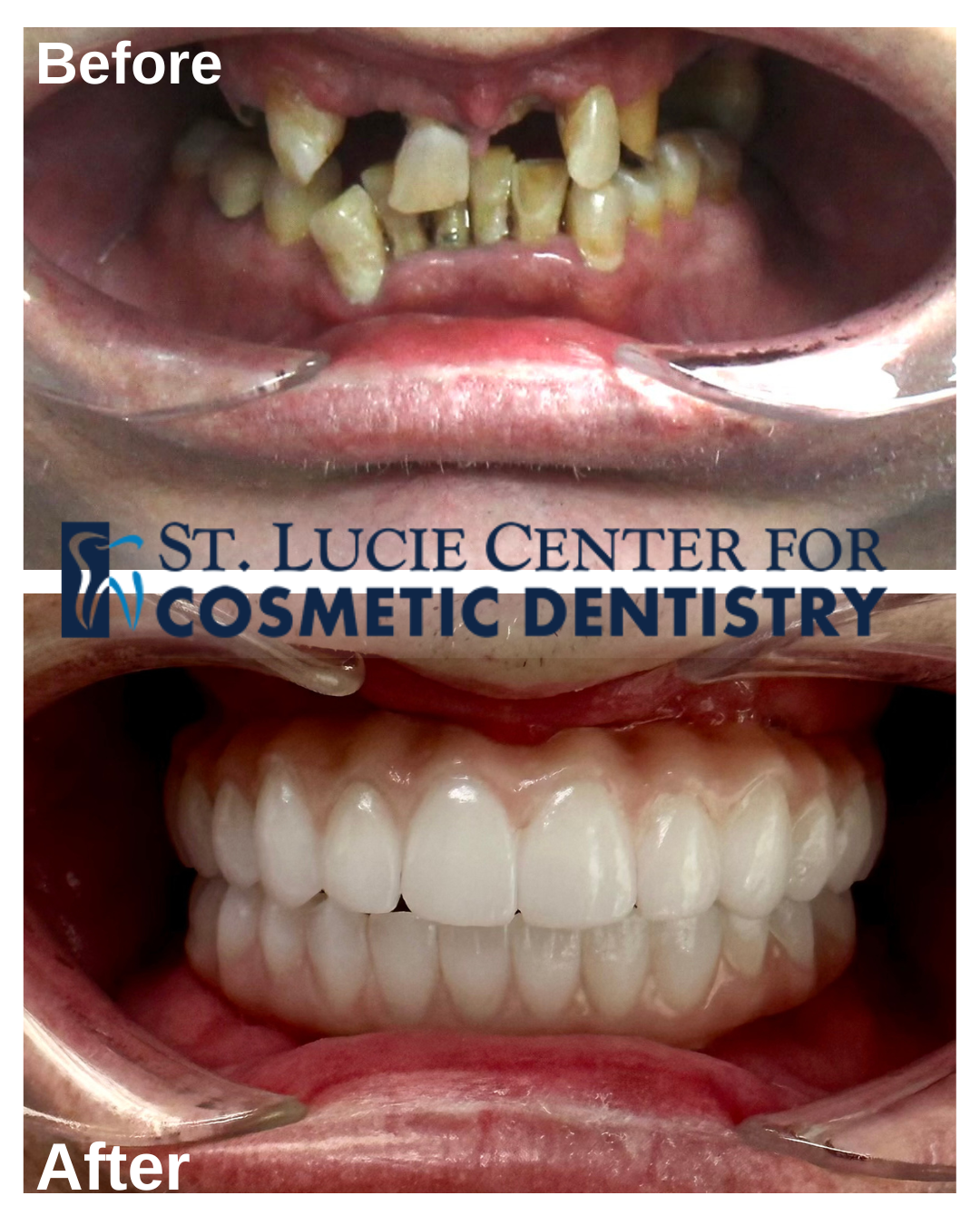The Science Behind Dental Implants
The Science Behind Dental Implants: How Osseointegration Creates a Permanent Solution

When it comes to replacing missing teeth, dental implants stand apart as the only solution that truly mimics the structure and function of natural teeth. For Port St. Lucie, Stuart, Jensen Beach, and Palm City residents considering tooth replacement options, understanding the science behind dental implants can help explain why they've become the gold standard in restorative dentistry.
At St. Lucie Center of Cosmetic Dentistry, led by Dr. Hans Almanzar, we believe that informed patients make better decisions about their dental health. This comprehensive guide explains the remarkable biological process of osseointegration that makes dental implants so successful and provides such transformative results for our St. Lucie County patients.
According to the American Academy of Implant Dentistry, dental implants have a success rate of up to 98% – higher than any other tooth replacement option. This impressive statistic is largely due to the biological process we'll explore in this article.
In This Article:
- What is Osseointegration? The Key to Implant Success
- Dental Implant Structure: Designed for Integration
- The Osseointegration Process: Timeline and Stages
- Factors Affecting Successful Osseointegration
- Implant Materials and Surface Technologies
- How Implants Preserve Jawbone Structure
- Benefits of Osseointegration vs. Other Tooth Replacement Methods
- Monitoring Osseointegration Success
- Frequently Asked Questions About Implant Science
What is Osseointegration? The Key to Implant Success
The Biological Foundation of Dental Implant Success
Osseointegration, derived from the Greek "osteon" (bone) and the Latin "integrare" (to make whole), refers to the direct structural and functional connection between living bone tissue and the surface of a load-bearing artificial implant. In simple terms, it's the process by which your jawbone actually grows around and fuses with the dental implant, effectively making it part of your body.
This remarkable biological phenomenon was discovered in the 1950s by Swedish orthopedic surgeon Dr. Per-Ingvar Brånemark, who noticed that titanium chambers he had placed in rabbit bone for a different study had become permanently integrated with the bone and could not be removed. This accidental discovery led to the development of modern dental implants.
For our patients in Port St. Lucie and Stuart, osseointegration provides several unique advantages:
- Creates a permanent bond between implant and jawbone, similar to a natural tooth root
- Allows the implant to withstand the powerful forces of chewing and biting
- Enables the transfer of these forces to the surrounding bone, stimulating bone maintenance
- Provides stability that prevents movement or slipping (common issues with dentures)
- Creates a seal that prevents bacteria from entering the implant site
This biological integration is what sets dental implants apart from every other tooth replacement option. While bridges and dentures simply rest on or are attached to existing oral structures, implants become a functioning part of your body through osseointegration.
Dental Implant Structure: Designed for Integration
Modern dental implants used at St. Lucie Center of Cosmetic Dentistry are designed specifically to maximize the potential for successful osseointegration. Understanding the structure helps explain how they function:
The Three Key Components of a Dental Implant
- The Implant Fixture: The fixture is the part that’s surgically placed in the jawbone and undergoes osseointegration. Typically made of biocompatible titanium or titanium alloy, it features:
- A threaded or grooved design that increases surface area for bone contact
- Microscopic surface texturing that encourages bone cell adhesion
- Tapered or straight body designs optimized for different bone types
- Sizes and lengths customized for individual patients’ needs
- The Abutment: Once osseointegration is complete, an abutment is attached to the implant fixture. This component:
- Extends above the gumline
- Serves as the connection between the implant and the restoration
- Is typically made of titanium, zirconia, or gold alloy
- The Prosthetic Crown or Restoration: The visible portion that replaces your missing tooth, which:
- Is custom-crafted to match your natural teeth
- Can be made from porcelain, zirconia, or other durable materials
- Attaches to the abutment via cement or screw retention
For our Palm City and Jensen Beach patients, it's important to understand that only the implant fixture itself undergoes osseointegration. This is the foundation upon which the entire restoration depends.
The Osseointegration Process: Timeline and Stages
Osseointegration follows a predictable biological process that occurs over several months. For our St. Lucie County patients, understanding this timeline helps set realistic expectations for the complete dental implant process.
Initial Healing Phase (Days 1-7)
Immediately after implant placement at our Port St. Lucie office:
- A blood clot forms around the implant
- Inflammatory response begins, bringing healing cells to the area
- Initial soft tissue healing occurs
- Proteins adhere to the implant surface, creating a foundation for bone cells
Early Bone Formation (Weeks 2-4)
During this critical early stage:
- Osteogenic cells migrate to the implant surface
- Initial formation of immature bone tissue begins
- A preliminary matrix is created around the implant
- Woven bone begins to form, providing initial stability
Bone Remodeling (Months 1-3)
The body continuously improves the bone structure:
- Woven bone is gradually replaced with stronger lamellar bone
- Osteoblasts (bone-forming cells) deposit new bone matrix
- Blood vessels grow into the area, bringing nutrients
- Initial mechanical stability transitions to biological stability
Mature Integration (Months 3-6)
The final stage of the process:
- Continued bone remodeling and maturation
- Development of strong, organized bone structure
- Achievement of complete biological integration
- Implant is now ready to support the final restoration
For most of our Stuart and Port St. Lucie patients, the osseointegration process takes 3-6 months to complete. However, this timeline can vary based on individual healing factors, implant location, and whether additional procedures like bone grafting were performed.
While waiting for complete osseointegration, most patients can wear temporary restorations. With All-on-4 implants, patients can even receive fixed temporary teeth the same day as implant placement, allowing normal function during the osseointegration period.
Factors Affecting Successful Osseointegration
While dental implants have an impressive success rate, several factors can influence the osseointegration process. At St. Lucie Center of Cosmetic Dentistry, we carefully evaluate these factors for each patient from Jensen Beach, Palm City, and surrounding areas:
Key Factors That Impact Osseointegration
Patient-Related Factors
- Bone Quality and Quantity: Dense bone (typically found in the front of the lower jaw) integrates better than softer bone (often in the upper back jaw)
- Overall Health: Conditions like uncontrolled diabetes or autoimmune disorders can slow healing
- Smoking: Significantly reduces success rates by decreasing blood flow to the surgical area
- Age: While not a contraindication, older patients may experience slower healing
- Medications: Some medications, particularly bisphosphonates for osteoporosis, can affect bone metabolism
Surgical and Implant Factors
- Surgical Technique: Precision in preparation and placement is critical
- Implant Design: Surface texture, thread design, and material all influence integration
- Initial Stability: The implant must be stable immediately after placement
- Implant Loading Protocol: Premature loading can disrupt the integration process
- Implant Position: Proper spacing and angulation optimize force distribution
Post-Operative Care Factors
- Oral Hygiene: Excellent hygiene prevents infection that can compromise osseointegration
- Following Post-Op Instructions: Adhering to your dentist’s guidelines is essential
- Diet During Healing: Avoiding hard foods that place excessive force on healing implants
- Regular Check-ups: Allowing your dentist to monitor the healing process
At our Port St. Lucie practice, Dr. Almanzar conducts thorough pre-operative assessments to identify any risk factors and develop strategies to optimize osseointegration success for each patient's unique situation.
Implant Materials and Surface Technologies
The materials and surface treatments used in dental implants have evolved significantly over decades of research, all aimed at enhancing osseointegration. For St. Lucie County residents considering implants, understanding these advances helps explain the high success rates of modern implant therapy.
Modern Implant Materials
At St. Lucie Center of Cosmetic Dentistry, we utilize state-of-the-art implant systems with the following characteristics:
Titanium and Titanium Alloys
- The most commonly used implant material due to exceptional biocompatibility
- Forms a stable oxide layer that facilitates osseointegration
- Provides excellent strength-to-weight ratio for durability
- Grade 4 commercially pure titanium and Ti-6Al-4V alloy are most common
- Decades of clinical research support their safety and effectiveness
Zirconia Implants
- Metal-free alternative for patients with titanium sensitivity (extremely rare)
- White color can be advantageous in areas with thin gum tissue
- Highly biocompatible ceramic material
- Resistant to corrosion and plaque accumulation
- Less long-term research compared to titanium, but showing promising results
Surface Modifications That Enhance Osseointegration
Modern implants feature specialized surface treatments that dramatically improve integration with bone:
Microscopic Surface Texturing
- Sandblasted and Acid-Etched (SLA) Surfaces: Creates micro-roughness that increases surface area for bone contact
- Plasma-Sprayed Coatings: Adds a rough texture that improves mechanical interlocking with bone
- Laser-Modified Surfaces: Creates precise micro-patterns that guide bone cell attachment
Biochemical Surface Modifications
- Hydroxyapatite Coatings: Contains calcium phosphate, the same mineral found in natural bone
- Growth Factor Applications: Some implants incorporate proteins that stimulate bone formation
- Nanostructured Surfaces: Modifications at the nano level that mimic natural bone topography
Research published in the International Journal of Molecular Sciences has shown that these surface modifications can accelerate osseointegration by 30-40% compared to earlier implant designs, potentially reducing healing times for our Port St. Lucie patients.
How Implants Preserve Jawbone Structure
One of the most significant advantages of dental implants for our Stuart and Jensen Beach patients is their ability to preserve jawbone structure—a benefit directly related to the osseointegration process.
The Problem of Bone Resorption
When a tooth is lost, the body begins a process known as resorption, where the jawbone that once supported the tooth root begins to deteriorate:
- The alveolar bone (tooth-supporting bone) can lose up to 25% of its width in the first year after tooth loss
- Vertical height loss continues at a rate of approximately 0.5-1mm per year thereafter
- Over time, this bone loss can lead to facial collapse, shifting of remaining teeth, and difficulty wearing conventional dentures
- Traditional bridges and dentures do nothing to stop this progressive bone loss
How Osseointegrated Implants Maintain Bone
Dental implants preserve jawbone through a principle known as Wolff's Law, which states that bone will adapt to the loads under which it is placed:
- The osseointegrated implant transfers chewing forces to the surrounding bone
- This mechanical stimulation signals the body to maintain bone density and volume
- Osteoblasts (bone-building cells) remain active in the area around the implant
- The natural cycle of bone remodeling continues, preventing atrophy
For our Palm City patients, this bone preservation aspect is particularly important for maintaining facial aesthetics and preventing the premature aging appearance often associated with long-term denture use.
A study published in the Journal of Prosthetic Dentistry found that patients with implant-supported prostheses maintained significantly more jawbone over a 10-year period compared to those with conventional dentures.
Benefits of Osseointegration vs. Other Tooth Replacement Methods
The unique biological integration of dental implants provides numerous advantages over traditional tooth replacement options for our St. Lucie County patients:
Comparing Tooth Replacement Methods
| Feature | Osseointegrated Dental Implants | Traditional Fixed Bridges | Removable Dentures |
|---|---|---|---|
| Bone Preservation | Maintains jawbone through stimulation | No bone stimulation; progressive loss continues | May accelerate bone loss through pressure |
| Stability | Completely stable; fixed in jawbone | Fixed to adjacent teeth; stable but dependent on tooth health | Can shift, move, or loosen during use |
| Chewing Efficiency | 90-95% of natural teeth | 70-80% of natural teeth | 25-50% of natural teeth |
| Impact on Adjacent Teeth | None; preserves adjacent healthy teeth | Requires grinding down neighboring teeth | May place pressure on remaining teeth |
| Longevity | Potential lifetime with proper care | 7-15 years average | 5-7 years before needing replacement |
| Natural Feel | Most natural feel; patient often forgets it’s not their original tooth | Good feel but may notice difference at gumline | Always noticeable as a foreign object |
The osseointegration process is responsible for many of these advantages, creating a foundation that behaves more like a natural tooth root than any other dental prosthesis.
Monitoring Osseointegration Success
At St. Lucie Center of Cosmetic Dentistry, we carefully monitor the osseointegration process during follow-up appointments to ensure optimal outcomes for our Port St. Lucie, Stuart, and surrounding area patients.
How We Evaluate Successful Integration
Dr. Almanzar uses several clinical methods to assess osseointegration:
- Percussion Testing: Gently tapping the implant produces a solid sound when properly integrated (versus a dull sound indicating fibrous encapsulation)
- Mobility Testing: Using specialized instruments to measure any microscopic movement (successful implants should have no detectable mobility)
- Radiographic Evaluation: Digital X-rays show bone density around the implant and the absence of radiolucent (dark) areas that would indicate lack of integration
- Torque Testing: For abutment connection, specific torque values confirm implant stability
- Patient Symptoms: Absence of pain, swelling, or discomfort during function
Together, these evaluations provide a comprehensive assessment of osseointegration success before proceeding with the final restoration.
Frequently Asked Questions About Implant Science
For most of our Port St. Lucie patients, osseointegration takes approximately 3-6 months to complete. However, this timeline varies depending on implant location (lower jaw typically integrates faster than upper jaw), bone quality and density, and individual healing factors. Some newer implant systems and techniques may allow for accelerated protocols in select cases.
While osseointegration is successful in the vast majority of cases, failures can occur. The most common causes include poor surgical technique, infection, premature loading (putting too much force on the implant too soon), insufficient bone quantity or quality, certain medical conditions like uncontrolled diabetes, smoking, and some medications. At St. Lucie Center of Cosmetic Dentistry, we carefully screen for these risk factors and develop strategies to minimize them.




